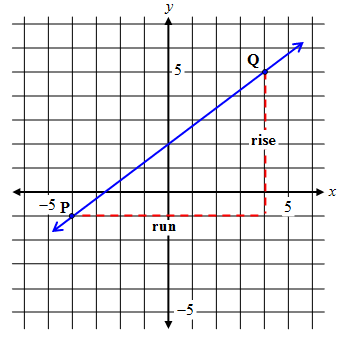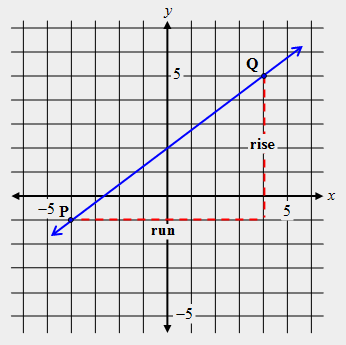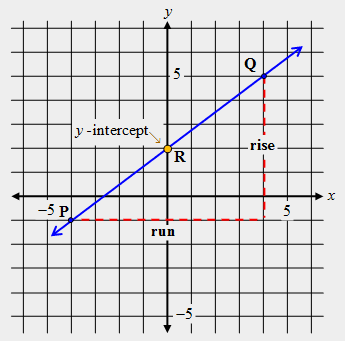| Consider the graph for points P(–4, –1) and Q(4, 5) on line PQ, and then answer the first ten questions. |
 |
|
| |
| 1) What is the vertical rise of line PQ? |
|
|
|
| |
|
| 2) What is the numerator of the slope equation? Assume point P(–4, –1) is the first point and point Q(4, 5) is the second point. |
 |
|
|
| |
|
| 3) What is the horizontal run of line PQ? |
 |
|
|
| |
|
| 4) What is the denominator of the slope equation? Assume point P(–4, –1) is the first point and point Q(4, 5) is the second point. |
 |
|
|
| |
|
| |
|
| 6) The point where the line crosses the y-axis is called the y-intercept. What are the coordinates of the y-intercept (Point R)? |
 |
|
|
| |
|
| |
|
| 8) True or False. The slope of line PQ can be calculated by using any two points on the line because any pair of points that fall on the line will produce the same slope. |
|
|
|
| |
|
| |
|
| 10) The form for an equation in slope-intercept form is y = mx + b where “m” represents the slope and “b” represents the y-intercept. The general form for the coordinate of the y-intercept is (0, b). Which equation represents line PQ? (Hint: Refer back to problem 5 and problem 6.) |
|
|
|
| |
|
| For the next four problems, graph the given points in a coordinate plane and draw a straight line through the points. Calculate the slope by counting the rise and run. Use the graph paper provided in the content section. Check the answer by substituting the x-values and the y-values of the points in the slope formula. |
 |
|
| |
| |
|
| |
|
| |
|
| |
|
| For the next seven questions, consider the equation, 3x + 2y = 6. |
|
|
| |
| |
|
| 16) What are the coordinates of the y-intercept? |
|
|
|
| |
|
| |
|
| 18) What are the coordinates of the x-intercept? |
|
|
|
| |
|
| |
|
| 20) Which equation represents equation 3x + 2y = 6 written in slope-intercept form? (Recall that slope-intercept form is y = mx + b where “m” represents the slope and “b” represents the y-intercept.) |
|
|
|
| |
|
| 21) The y-intercept is the point where the line crosses the ____________ and the x-intercept is the point where the line crosses the _____________. |
|
|
|
| |
|
| Refer to the following scenario to answer the next five questions. Tanya waits tables for customers in her mother’s restaurant. She earns an average $4.00 in tips for each table, and will make about 8 trips to the table for each meal. She makes a chart to show her work and tips for serving 8 to 12 tables. Use the chart to analyze the data and make predictions about Tanya's part-time job. |
 |
|
| |
| 22) Describe in words the range of money Tanya can earn for serving customers at 8 to 12 tables. |
|
4000 character(s) left
Your answer is too long. |
|
| |
|
| |
|
| |
|
| |
|
| 26) If the expression “y = 4x” is used to describe a part of the problem, what would it be describing? |
|
4000 character(s) left
Your answer is too long. |
|
| |
|
| |
| 27) Due to slow moving traffic, Allen traveled an average of 35 MPH for 4 hours. The traffic cleared, and then he was able to travel an average of 70 MPH for 4 hours. Allen traveled many more miles at the faster speed than at the slower speed. (a) How many miles did Allen travel at the slower speed? (b) How many miles did Allen travel at the faster speed? (c) Compare the number of miles traveled at the slower speed to the number of miles traveled at the faster speed. The number of miles traveled at the faster speed is how many time greater than the number of miles traveled as the slower speed? |
 |
4000 character(s) left
Your answer is too long. |
|
| |
|
| 28) The previous problem is an example of what kind of variation? |
|
|
|
| |
|
| 29) For the given equation determine if “y” varies directly or indirectly to “x”. Test various values for “x” and make a table to decide if “y” varies directly or indirectly. . |
 |
|
|
| |
|
| |
|
| 31) For the relation given in the previous problem, predict the next three ordered pairs. |
|
4000 character(s) left
Your answer is too long. |
|
| |
|
| On graph paper, draw the following trapezoid six times in six different coordinate planes: A(1, 1), B(2, 3), C(5, 3), D(6, 1). Use the illustrations of the six trapezoids to solve the next six problems. (Graph paper is provided in the content section.) |
|
|
| |
| 32) Translate trapezoid ABCD right 3 units, and then state the new coordinates. |
|
4000 character(s) left
Your answer is too long. |
|
| |
|
| 33) Translate the original trapezoid ABCD up 5 units, and then state the new coordinates. |
|
4000 character(s) left
Your answer is too long. |
|
| |
|
| 34) Rotate the original trapezoid ABCD 180 degrees about the origin, and then write the new coordinates. |
|
4000 character(s) left
Your answer is too long. |
|
| |
|
| 35) Rotate the original trapezoid ABCD 360 degrees and write the new coordinates. |
|
4000 character(s) left
Your answer is too long. |
|
| |
|
| 36) Reflect the original trapezoid ABCD over the x-axis and write the new coordinates. |
|
4000 character(s) left
Your answer is too long. |
|
| |
|
| 37) Reflect the original trapezoid ABCD over the y-axis and write the new coordinates. |
|
4000 character(s) left
Your answer is too long. |
|
| |
|
| |
|
| |
|
| |
|
| |
|
| |
|
| |
|
| |
|
| 45) If you were directed by your school to complete Offline Activities for this course, please enter the information on the Log Entry form. |
|
| No offline activities found |
| 0 Hour(s) & 0 Minute(s) |
|
|
Attachments |
|